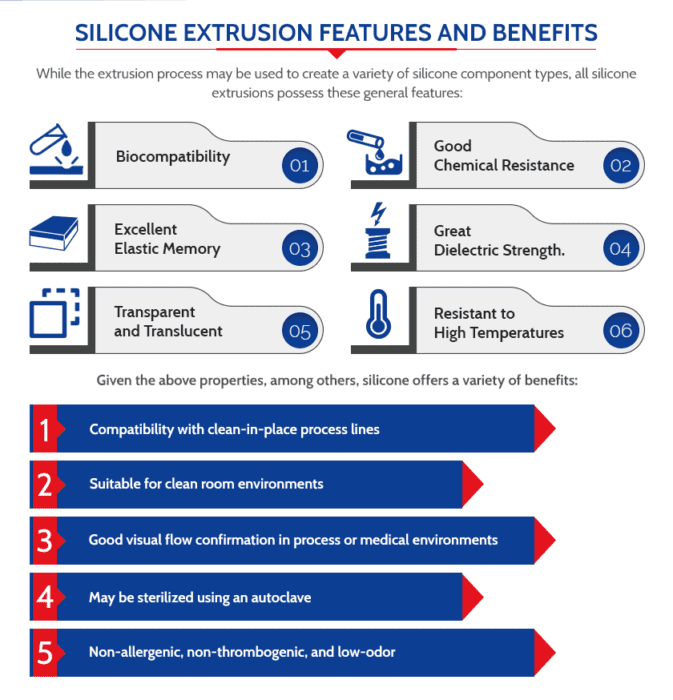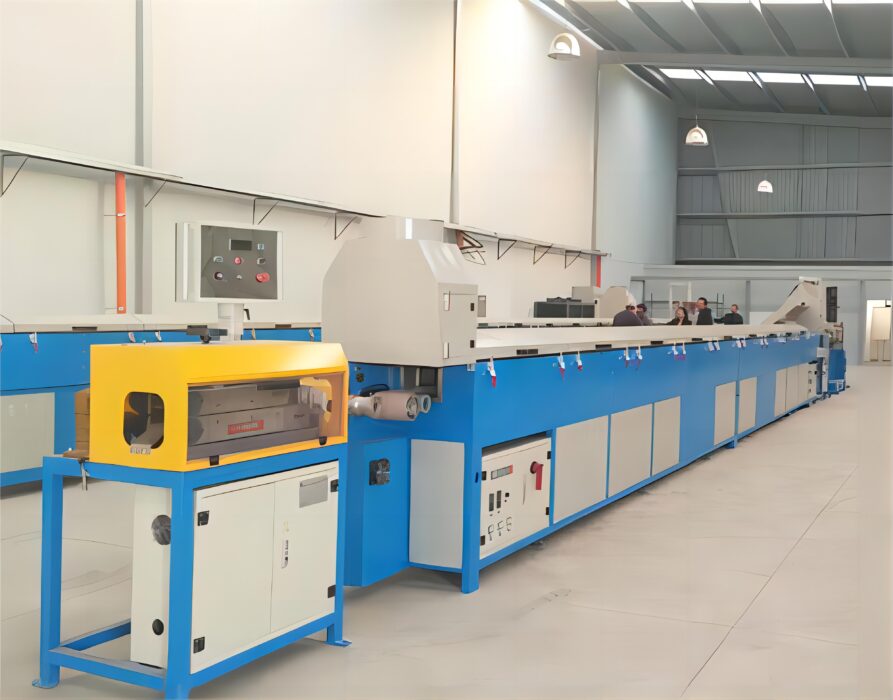Als gevolg van de vooruitgang in de productiemogelijkheden van de afgelopen tijd 30 jaren, het aangepaste siliconenextrusieproces is toegankelijker geworden. Vervolgens, siliconen zijn het meest gebruikte elastomeer geworden voor gebruik in technische producten.
Wat is siliconenrubberextrusie?
Extrusie van siliconenrubber is een proces waarbij massief siliconenrubber door een matrijs met de gewenste doorsnede wordt geduwd of getrokken om doorlopende profielen te vormen. De flexibiliteit van siliconen maakt de productie van ingewikkelde vormen mogelijk die met andere materialen niet mogelijk zijn.
Instructies voor extrusie-siliconenverbinding
De siliconenverbinding die bij de extrusie wordt gebruikt, is extreem trillingsbestendig, thermische schok, en veranderende klimatologische omstandigheden. Het is ideaal voor een verscheidenheid aan toepassingen vanwege de uitzonderlijke scheursterkte en slijtvastheid. Extrusie-siliconenverbinding is perfect voor de elektronica, automobiel, en de medische industrie, omdat het ook superieure elektrische isolatiekwaliteiten heeft. Om aan de behoeften van de consument te voldoen, het materiaal met lage toxiciteit wordt aangeboden in verschillende tinten, texturen, en vormen. Het is een fantastische keuze voor buitentoepassingen vanwege zijn uitstekende weerbestendigheid. Extrusiesiliconencompound zal zeker voldoen aan de behoeften van uw projecten dankzij zijn uitzonderlijke eigenschappen.
Siliconen extrusievormen
Bij LgdSilicone, Wij kunnen siliconenextrusies leveren in een breed scala aan profielen, inbegrepen:
- “D”-profielen zorgen voor een zachte afdichting en kunnen massief of hol zijn
- “e”-profielen bevatten een holle afdichting en groef
- “H”-profielen sluiten twee aangrenzende panelen af
- “L”-profielen voor hoektoepassingen
- “T”-profielen worden vaak gebruikt voor voedselverpakkingen
- “U”-profielen bieden randbescherming voor panelen
- Aangepaste profielen

Typische toepassingen van geëxtrudeerde siliconenprofielen
- Automobiel – Afdichtingen & Pakkingen
- Lucht- en ruimtevaart- en militaire zegels & Pakkingen
- Vleesverwerking – Luikafdichting, Kamerzegels
- Verlichtingsindustrieën-
- Bouw -(deurafdichtingen, raamafdichtingen, beschermende afdichtingen tussen glas & staal)
- Slangen voor het verwerken van zuivelvloeistoffen en zuivelafdichtingen
- Elektronische wasmachines, afstandhouders, en zegels
- Deurafdichtingen & Pakkingen
- Oven- en mangatafdichtingen
- Afdichting op hoge temperatuur
- HVAC-apparatuur – draadafdichtingen, conditionering van afdichtingskamers
- Spoor- en massavervoerzegels
- Olie & Gasbestendige afdichtingen
- Farmaceutische USP klasse Vi-slangen en aangepaste afdichtingen
- Medische siliconen extrusie:slangen
Ons siliconenmateriaal voldoet aan het volgende
- FDA-regelgeving 21CFR177.2600 voor contact met voedsel
- NSF 51 Goedgekeurd materiaal
- Chemische weerstand
- 3Een sanitair
- ZZ-R-765 Ingehaald door A-A59588
- ASTM D2000, AMS 3304
- USP CL-VI-materiaal
- Siliconen voor hoge temperaturen
- 10 Kust A naar 90 Kust A
Het siliconenextrusieproces
1. De siliconenverbinding wordt in de extruder gevoerd
2. De volgende stap omvat het aanvoeren van materialen in de invoertrechter
3. Het materiaal wordt vervolgens in verschillende groeven in de draaiende schroef gevoerd
4. De schroef zal het rubber naar voren in de matrijs brengen en druk uitoefenen naarmate het materiaal dichter bij de matrijs komt
5. Vervolgens wordt de siliconen door de extrusiematrijs geperst om het gewenste profiel te vormen
6. Eindelijk,het geëxtrudeerde profiel gaat door een oven die het product uithardt met stralingswarmte
Siliconen extrusie-eigenschappen
Hoewel er met de extrusietechniek een groot aantal typen siliconencomponenten kan worden geproduceerd, alle siliconenextrusies hebben de volgende gemeenschappelijke kenmerken:
- Biocompatibiliteit. Siliconen zijn over het algemeen niet giftig en niet-allergeen. Vanwege het feit dat het normaal gesproken geen nadelige effecten heeft bij contact met de menselijke huid of weefsel, deze eigenschap maakt het uitstekend geschikt voor gebruik in medische apparaten.
- Goede chemische resistentie. Omdat siliconen een inerte substantie zijn die niet reageert met de meeste chemicaliën, het is eenvoudig schoon te maken en geschikt voor sommige procestoepassingen. Echter, sommige geconcentreerde zuren hebben het potentieel om siliconen op te lossen, daarom is het van cruciaal belang om te bepalen of het gekozen materiaal compatibel is met de chemicaliën die in de beoogde toepassing worden gebruikt.
- Goed elastisch geheugen. Wanneer blootgesteld aan sterke druk of drukkrachten, siliconen proberen voortdurend hun vorige vorm aan te nemen.
- Sterke diëlektrische eigenschappen. Geëxtrudeerde siliconenmaterialen functioneren goed als elektrische isolatoren en zullen niet degraderen of geleidend worden wanneer ze regelmatig aan stroom worden blootgesteld.
- Transparant van uiterlijk. Geëxtrudeerde siliconen zijn relatief transparant, waardoor het eenvoudig is om toepassingen met bijzondere esthetische of organisatorische vereisten in te kleuren. Bovendien, het maakt het ideaal voor de productie van heldere buizen.
- Bestand tegen extreme hitte. De meeste siliconenextrusies zijn bestand tegen temperaturen tot 500°F.

Voordelen van siliconenextrusie
- compatibiliteit met clean-in-place productieprocessen
- geschikt voor cleanroom-omgevingen
- betrouwbare visuele stroombevestiging in industriële of medische omgevingen
- met behulp van een autoclaaf om te steriliseren
- geurarm, niet-trombogeen, en niet-allergeen
Siliconen extrusiemachine
siliconen extrusiemachine is ontworpen om fabrikanten te helpen een verscheidenheid aan vormen te creëren, maten, en texturen van siliconenproducten. De siliconen extrusielijn maakt gebruik van volledige automatiseringssystemen om fouten te verminderen en tegelijkertijd de precisie te vergroten. Het kan snel schakelen tussen gereedschapsets, waardoor snelle productiewijzigingen mogelijk zijn zonder extra insteltijd. Deze geavanceerde technologie zorgt ervoor dat siliconenproducten vervaardigd met behulp van een extrusiemachine van de hoogste kwaliteit zijn. Verder, Door de eenvoudige constructie is deze apparatuur gemakkelijk te onderhouden en schoon te maken, waardoor een efficiënte productie mogelijk is zonder dat dit ten koste gaat van de veiligheids- of hygiënenormen.

Specificaties voor siliconenextrusie
Tips: Op maat gemaakte siliconen extrusies vervaardigd volgens uw exacte specificaties
| Mogelijkheden | Enkel, co-extrusie, tri-extrusie |
| Extrusie proces | Multi-lumen, multi-durometer, veelkleurig, invoegen |
| Doorsnede | 0.010” tot 3” |
| Aangepaste formuleringen | Mechanische eigenschappen, chemische weerstand, temperatuursbestendigheid, elektrische eigenschappen, thermische eigenschappen, kleurafstemming |
| Diensten met toegevoegde waarde | Stansen, lijm toepassing, snijden, binding, frame- en O-ringfabricage, speciale opstellingen, speciale verpakking, PSA-toepassing |
| Productiemogelijkheden | Lage tot hoge volumes |
| Doorlooptijden | Berekend per project |
| Certificeringen/normen | ISO 9001:2015, FDA21CFR177.2600, NSF-51, 3A, USP-VI, Mil-Spec (ZZ-R-765, A-A 59588, AMS 3304, ASTMD2000 GE) |
Veelgestelde vragen over siliconen extrusies
Kunnen siliconen worden geëxtrudeerd?
De methode waarbij siliconen door een gevormde matrijs worden geperst om een ononderbroken stuk materiaal met ingewikkelde dwarsdoorsneden en profielen te maken, staat bekend als siliconenextrusie.. Omdat siliconen een synthetisch rubber is, zijn elastische eigenschappen maken het de perfecte substantie om te gebruiken bij extrusie.
Hoe werkt siliconenextrusie??
Wat is het extrusieproces voor siliconenrubber??
Een door hitte uitgeharde siliconen (HCR) verbinding die een katalysator bevat, wordt tot een strip of plaat bereid om het proces te starten.
Daarna, een schroefextruder wordt geladen met de siliconen perform, waarbij de verbinding door een matrijs van gehard staal wordt geperst. De extruderkop houdt de matrijs vast, en nadat het siliconenrubber door de matrijs is gedrukt, de matrijs geeft het siliconenrubber zijn vorm.
Op welke temperatuur extrudeer je siliconenrubber??
De extrusie wordt verwerkt in een horizontale kamer verwarmd tot 250-500°C of een verticale kamer verwarmd tot 700°C. Extrusies met kleine doorsneden vulcaniseren binnen enkele seconden, terwijl die met grotere dwarsdoorsneden verhoudingsgewijs langer duren.
Gespecialiseerde productie van siliconenextrusie
Wij kunnen eenmalige specialistische extrusies vervaardigen die specifiek zijn voor uw project. Alsjeblieft neem contact met ons op voor hulp en advies of voor meer informatie fabrikant van siliconen extrusie detail.